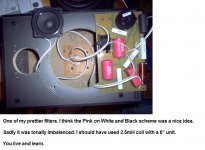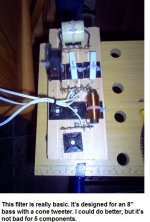The whole squealing issue reminds me of the days when I was involved with Video Card issues for the PC gamers. NVidia cards and some motherboards would produce an annoying high pitched squeal when stressed by a heavy workload. This REALLY annoyed the Gang Green poeple who'd spent megabucks on the latest hot stuff."According to Clarity Cap, the cheap film caps are going to squeal at around 15kHz. Who knows?"
Yeah I'd trust Clarity to be non biased
I don't make this up! MSI solves Nvidia GTX 200 squealing problem | bit-tech.net
It was the ferrite chokes on the power supplies doing most of the squealing. Gang Red aka AMD had tackled the problem years earlier.
simon7000, most of us give our time and energy and occasional wisdom for NOTHING here. We are truly altruistic, like those old Greek Mathematicians. This makes for a better World, safe for our children IMO.
simon7000, most of us give our time and energy and occasional wisdom for NOTHING here. We are truly altruistic, like those old Greek Mathematicians. This makes for a better World, safe for our children IMO.
And if you ask a question, I will answer it. SY is a special case.
I thought it was clear that with 9 volts of DC you got worst case 500uV of microphonic effect. That is 85 db down.Take it for what you will.
You could buy the article!
Had you cited it, I might have.
This popped up while I was searching my files for something totally unrelated!
I test lots of different types of capacitors, this shows one of the worst. I never got to try SY's favorite loosely wound audophile specials.
A DC voltage was applied to the D.U.T. through a resistor. 9V/10K if I recall correctly. They were then placed on a woofer turned into a shaker table.
While grabbing the image the legend seems to have gotten lost. So what is here is a Mylar cap and an aluminum elctrolytic, two samples mounted vertically and horizontally. Base line is a shorted test lead.
Well, I was brought up on the "hypothesis, test, results, conclusion" school of science. If you don't mind me saying so, D.U.T. was a term that initially lost me, and I didn't understand the reference to SY at all.
And if you ask a question, I will answer it. SY is a special case.
I thought it was clear that with 9 volts of DC you got worst case 500uV of microphonic effect. That is 85 db down.Take it for what you will.
Now THAT I understand. The microphonic effect is small. That's what you call a conclusion.
The original graph still leaves me, and doubtless everyone else, confused though. I understand you had problems uploading it, but still, it was not clear. It probably works best as a piece of abstract art.
I am starting to think that capacitors and resistors really do work as advertised. It's the flippin' COILS and circuit boards and earthing arrangements we gotta look out for!
Attachments
Well, I was brought up on the "hypothesis, test, results, conclusion" school of science.
The other end of it is giving sufficient experimental detail for evaluation and replication. That's a favorite trick, leaving out vital details, controls, and error bars.
I do have to say that this thread has changed my way of thinking about crossovers. 
Clearly my "Pink Noise" PCB filter is severely flawed. The coils interacting with the ground plane and particularly the LCR woofer notch are probably not working well. No amount of Clarity Caps and Mundorf Coils and resistors will rescue it.
The wood and stripboard filter based on Troels Gravesen ideas will probably work as expected.
We are, after all, artists. system7 out.
Clearly my "Pink Noise" PCB filter is severely flawed. The coils interacting with the ground plane and particularly the LCR woofer notch are probably not working well. No amount of Clarity Caps and Mundorf Coils and resistors will rescue it.
The wood and stripboard filter based on Troels Gravesen ideas will probably work as expected.
We are, after all, artists. system7 out.

Attachments
The other end of it is giving sufficient experimental detail for evaluation and replication. That's a favorite trick, leaving out vital details, controls, and error bars.
I have no need for error bars as I never make mysteaks. C'mon SY I have posted this before.
I figured when support for Windows XP stopped I should move to another than Microsoft security software package. So I loaded a new one and a week later I let it run a full scan. Next day during boot up everything was erased. So although I have the final articles and much of the raw data recovered, the directories and file sorting was lost.
Now if you ask nice via PM I can send you the original article.
MSI solves Nvidia GTX 200 squealing problem | bit-tech.net[/url]
It was the ferrite chokes on the power supplies doing most of the squealing. Gang Red aka AMD had tackled the problem years earlier.
My GTX260 AND my power supply squeal when the system is under load. Heck my PSU even makes some noise when the PC is doing nothing and I move the mouse around. It is really annoying as the rest of the design is 'silent' so it sticks out like a sore thumb. I don't really want to modify my graphics card with new inductors, but it is something to consider
I know I said I was out on this thread, but I can certainly revisit my PC forum years.My GTX260 AND my power supply squeal when the system is under load. Heck my PSU even makes some noise when the PC is doing nothing and I move the mouse around. It is really annoying as the rest of the design is 'silent' so it sticks out like a sore thumb. I don't really want to modify my graphics card with new inductors, but it is something to consider
The major problems with a PC gamer are the huge cooling problems. What is it? 300-400W of heat to lose? It never changes somehow, though I don't follow the latest developments. Problem components are the fans with ball-bearings rattling, coils squealing, and ceramic layer capacitors (those little flat brown things) microphoning, and doubtless squealing too. All this in a lively metal cabinet.
The fact is a standard PC makes a lot of high frequency noise. Along with the underestimated blue light LED irritation. Try sleeping through it!
I used to read silentpcreview.com | Everything about Silent / Quiet Computers a lot. My Corsair TX650W power supply worked much better than a lot of stuff. But the modern World is not a silent place. No wonder we can never agree on loudspeakers. Too much noise to sensibly evaluate ANYTHING!
A cite will do fine. I hate the PM system here.
My friend the accelerometer in elektor. A few years back when Ed was first trying to sell AX.
I'm going to disagree with that sentiment. Most MKP has lower ESR than MKT, yes. However, ESR aside, I have found that some F/F MKT-oil caps have allowed my midrange to sound more open and textures are more easily discerned. These aren't cheap caps either, but I still prefer them over some metallized polys I have also used.
Just in case anyone was interested, the Dupont-Mylar infused F/F caps I'm referring to are the:
LQ10-105V
LQ10-205V
LQ10-405V
Plastic Capacitors, Inc. - Products - Type LQ
I have them in parallel to make a 7uF since they only go up to 4uF. I will say they did have a higher ESR than some of the MKP caps I've tried, and I compensated by using a larger gauge LP coil in the same circuit on the midrange. Since the graphs for the product are posted on the website, I figured this would be welcome to the party. I know they are for industrial power applications, but the company did say some loudspeaker manufacturers have used this line of caps in their products before.
Again- FWIW,
Wolf
My friend the accelerometer in elektor. A few years back when Ed was first trying to sell AX.
Thanks- that I can get access to, and now everyone can look at it if they wish.
"I have them in parallel to make a 7uF since they only go up to 4uF. I will say they did have a higher ESR than some of the MKP caps I've tried, and I compensated by using a larger gauge LP coil in the same circuit on the midrange"
Just how high an ESR are you talking about? Paralleling them would half the ESR.
Just how high an ESR are you talking about? Paralleling them would half the ESR.
- Status
- This old topic is closed. If you want to reopen this topic, contact a moderator using the "Report Post" button.
- Home
- Loudspeakers
- Multi-Way
- Capacitor quality for crossover


